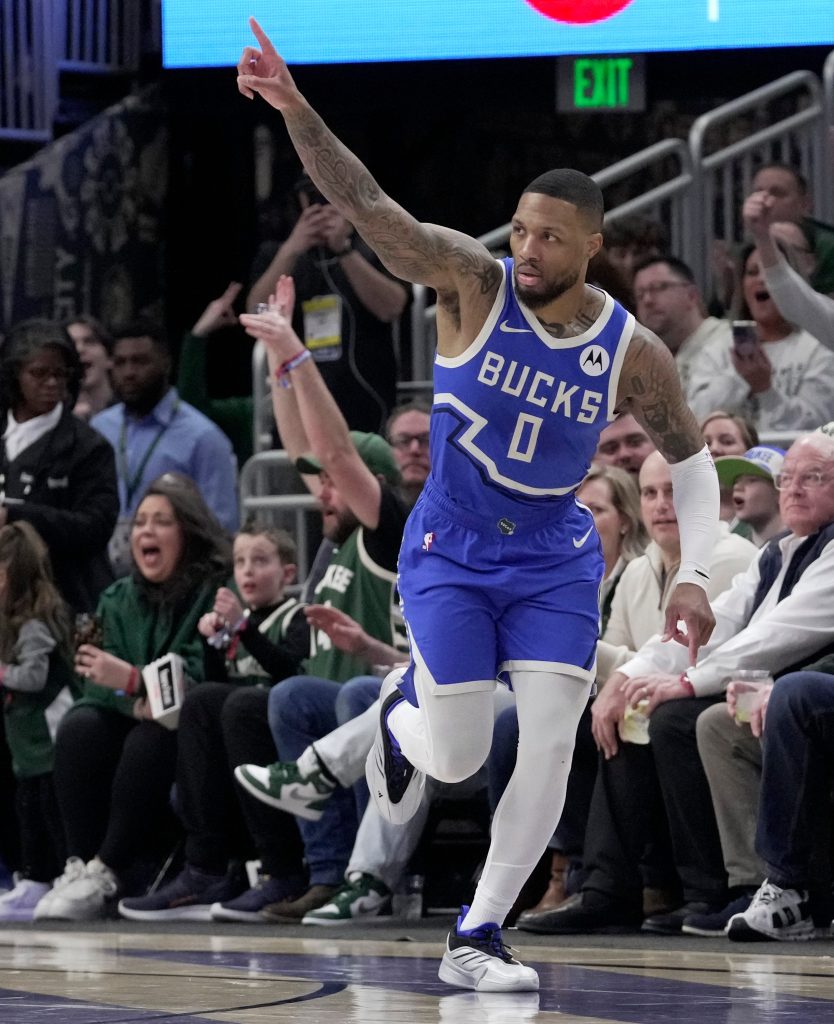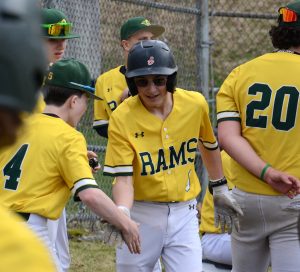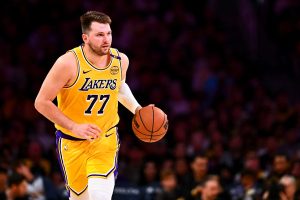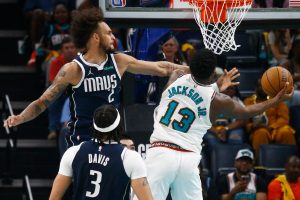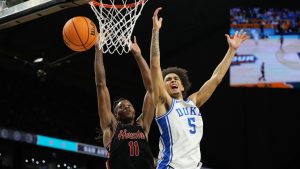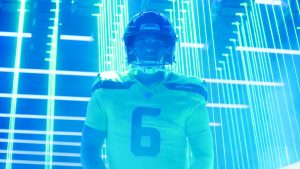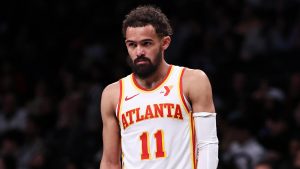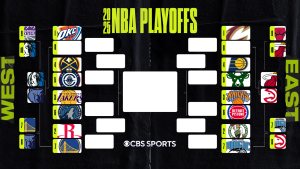Milwaukee Bucks all-star Damian Lillard met with the media April 18 in advance of the team’s first-round playoff series against Indiana, making his first public comments since the team announced he had been diagnosed with deep vein thrombosis in his right calf on March 25.
The Bucks didn’t go through an entire practice in advance of their afternoon flight to Indianapolis, but it was the second day in a row Lillard participated without limitation.
He said that the specialists and doctors he had been seeing acknowledged this was a remarkably quick recovery from such a diagnosis.
“They were just like, ‘we don’t see this,'” Lillard said. “For me, I was just like, it was a different experience for me because I went in there a bunch of times and it was the same size. So I’m like, it didn’t seem that special and then it just reached a point where it just got a lot smaller out of nowhere. They did say that.”
But through the process, Lillard said returning to play was not top of mind.
He talked about a family member who died from a clot that traveled from a leg to the lungs during the global coronavirus pandemic, and how treating a blood clot was so unlike anything he had experienced physically.
“Obviously that’s a thing that can affect your life,” he said. “I’ve got kids. I’ve got a big family. I’m tight with my family. So automatically I start thinking about what it could mean for me personally, so that was the scariest part.”
He last played on March 18 and was initially ruled out of the March 20 game in Los Angeles against the Lakers with what was initially called soreness in the soleus muscle in his right calf. That discomfort was somewhat comparable to what he had felt before in his career, but he also experienced abnormal swelling that required more thorough testing.
“My leg just felt swollen,” he said. “It was like super tight. And that was kind of what led me to go to the team in the first place, because I was just like ‘This ain’t normal.’ We went from there.”
Started on blood thinning medication immediately, he did not travel to the Bucks’ next game in Sacramento on March 22 and rejoined the team in Phoenix on March 24.
Lillard said he felt normal after about four of five days of treatment, but knowing that there was still a problem was nerve-wracking.
“I mean, just looking at the time that I spent just not playing and the millions of thoughts that went through my head like man, what if this, what if that, I was panicking,” he said. “My back randomly started hurting, my chest started hurting and I’m like man, is it moving? I’m thinking all kind of stuff.”
There was optimism from the beginning that Lillard could return during this postseason, even though no NBA player had come back from a DVT diagnosis in the same season since since Brooklyn’s Mirza Teletović in 2015. But that even took Teletović three months to return from a pulmonary embolism (a clot in the lungs).
Houston’s Hakeem Olajuwon was initially ruled out for the season in early March 2001 with a blood condition doctors treated like a clot, but only missed five games before returning on March 17.
“I didn’t really ask the question about when can I play?” Lillard said. “I was just like when, how long these usually take to go away before it’s not an issue. A lot of times they give you the timelines they would give anybody. The term they kept using was you’re not a 65-year-old person coming in that usually would have a blood clot. It’s like you’re a 34-year-old athlete, you’re in good shape, your body is strong, that was kind of like the language they used.”
More: Three things the Bucks can do to win their first-round NBA playoff series against Pacers
He also felt the fact that he had the ability to go in for imaging and testing weekly, as opposed to a more prolonged appointment schedule, allowed for the doctors to notice improvement and get him on the path to a return to play.
Because of that, Lillard said he was cleared to do specific exercises, and he noted he was able to bike, lift weights and get in the pool to get his heart rate up and stay in some semblance of shape. As for basketball activities, he had been able to only shoot free throws and do light running, but his condition rapidly progressed this last week. On Tuesday the Bucks announced Lillard was cleared to do more “basketball activity,” which head coach Doc Rivers said was walkthrough-type work and more shooting. On Wednesday he played three-on-three and on Thursday he graduated to a full practice with no limitations.
“Honestly, when I say I was scared, I was really nervous about it, based off of a past experience, so I wasn’t really thinking about, ‘Oh, I need to get back out there for the playoffs,'” he said. “I was just like each time I went back to the hospital, I wanted to hear that it’s gone or it’s smaller or it’s in the same spot, so that was more of my focus.”
He is unlikely to play in Game 1 in Indianapolis on Saturday, but now there is legitimate hope from the team he can suit up at some point in the first round. If it goes seven games, the series could stretch to May 4.
Neither Lillard or Rivers would put a timeline on his return to action, but the point guard did say as soon as he felt ready he will not hesitate to say so.
“Looking back I think you just gotta not take each day for granted because you never know when an issue could come up,” he said of the last few weeks. “Obviously there’s people with way worse issues than I’ve dealt with, so I don’t want to be dramatic about it, but you just never know when something could come up and change your life. It’s been guys like Chris Bosh who dealt with this and then it’s another issue and it could be a career-ending thing so I think you just can’t take days and opportunities and things in your life for granted. That’s kind of how I look back at the experience.”
This article originally appeared on Milwaukee Journal Sentinel: Bucks star Damian Lillard speaks on return after blood clot diagnosis
Milwaukee Bucks all-star Damian Lillard met with the media April 18 in advance of the team’s first-round playoff series against Indiana, making his first public comments since the team announced he had been diagnosed with deep vein thrombosis in his right calf on March 25.
The Bucks didn’t go through an entire practice in advance of their afternoon flight to Indianapolis, but it was the second day in a row Lillard participated without limitation.
He said that the specialists and doctors he had been seeing acknowledged this was a remarkably quick recovery from such a diagnosis.
“They were just like, ‘we don’t see this,'” Lillard said. “For me, I was just like, it was a different experience for me because I went in there a bunch of times and it was the same size. So I’m like, it didn’t seem that special and then it just reached a point where it just got a lot smaller out of nowhere. They did say that.”
But through the process, Lillard said returning to play was not top of mind.
He talked about a family member who died from a clot that traveled from a leg to the lungs during the global coronavirus pandemic, and how treating a blood clot was so unlike anything he had experienced physically.
“Obviously that’s a thing that can affect your life,” he said. “I’ve got kids. I’ve got a big family. I’m tight with my family. So automatically I start thinking about what it could mean for me personally, so that was the scariest part.”
He last played on March 18 and was initially ruled out of the March 20 game in Los Angeles against the Lakers with what was initially called soreness in the soleus muscle in his right calf. That discomfort was somewhat comparable to what he had felt before in his career, but he also experienced abnormal swelling that required more thorough testing.
“My leg just felt swollen,” he said. “It was like super tight. And that was kind of what led me to go to the team in the first place, because I was just like ‘This ain’t normal.’ We went from there.”
Started on blood thinning medication immediately, he did not travel to the Bucks’ next game in Sacramento on March 22 and rejoined the team in Phoenix on March 24.
Lillard said he felt normal after about four of five days of treatment, but knowing that there was still a problem was nerve-wracking.
“I mean, just looking at the time that I spent just not playing and the millions of thoughts that went through my head like man, what if this, what if that, I was panicking,” he said. “My back randomly started hurting, my chest started hurting and I’m like man, is it moving? I’m thinking all kind of stuff.”
There was optimism from the beginning that Lillard could return during this postseason, even though no NBA player had come back from a DVT diagnosis in the same season since since Brooklyn’s Mirza Teletović in 2015. But that even took Teletović three months to return from a pulmonary embolism (a clot in the lungs).
Houston’s Hakeem Olajuwon was initially ruled out for the season in early March 2001 with a blood condition doctors treated like a clot, but only missed five games before returning on March 17.
“I didn’t really ask the question about when can I play?” Lillard said. “I was just like when, how long these usually take to go away before it’s not an issue. A lot of times they give you the timelines they would give anybody. The term they kept using was you’re not a 65-year-old person coming in that usually would have a blood clot. It’s like you’re a 34-year-old athlete, you’re in good shape, your body is strong, that was kind of like the language they used.”
More: Three things the Bucks can do to win their first-round NBA playoff series against Pacers
He also felt the fact that he had the ability to go in for imaging and testing weekly, as opposed to a more prolonged appointment schedule, allowed for the doctors to notice improvement and get him on the path to a return to play.
Because of that, Lillard said he was cleared to do specific exercises, and he noted he was able to bike, lift weights and get in the pool to get his heart rate up and stay in some semblance of shape. As for basketball activities, he had been able to only shoot free throws and do light running, but his condition rapidly progressed this last week. On Tuesday the Bucks announced Lillard was cleared to do more “basketball activity,” which head coach Doc Rivers said was walkthrough-type work and more shooting. On Wednesday he played three-on-three and on Thursday he graduated to a full practice with no limitations.
“Honestly, when I say I was scared, I was really nervous about it, based off of a past experience, so I wasn’t really thinking about, ‘Oh, I need to get back out there for the playoffs,'” he said. “I was just like each time I went back to the hospital, I wanted to hear that it’s gone or it’s smaller or it’s in the same spot, so that was more of my focus.”
He is unlikely to play in Game 1 in Indianapolis on Saturday, but now there is legitimate hope from the team he can suit up at some point in the first round. If it goes seven games, the series could stretch to May 4.
Neither Lillard or Rivers would put a timeline on his return to action, but the point guard did say as soon as he felt ready he will not hesitate to say so.
“Looking back I think you just gotta not take each day for granted because you never know when an issue could come up,” he said of the last few weeks. “Obviously there’s people with way worse issues than I’ve dealt with, so I don’t want to be dramatic about it, but you just never know when something could come up and change your life. It’s been guys like Chris Bosh who dealt with this and then it’s another issue and it could be a career-ending thing so I think you just can’t take days and opportunities and things in your life for granted. That’s kind of how I look back at the experience.”
This article originally appeared on Milwaukee Journal Sentinel: Bucks star Damian Lillard speaks on return after blood clot diagnosis
